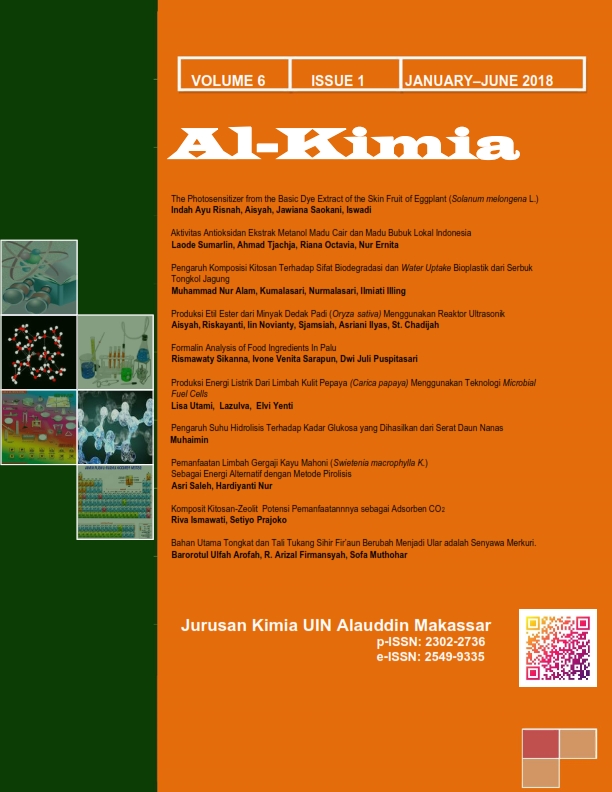Pengaruh Suhu Hidrolisis Terhadap Kadar Glukosa yang Dihasilkan dari Serat Daun Nanas
Abstrak
The purpose of this study was to determine the effect of temperature on glucose levels produced during the process of hydrolysis of pineapple leaves using 0.5M of sulfuric acid catalyst. The temperature used in the hydrolysis process is 30 °C and 120 °C while the time variation used for the determination of glucose is 0.15,45,75,105,135 minutes. The method of glucose analysis used is to use is phenol-sulfuric acid to determine total glucose. The results showed that the highest glucose level was achieved at 120 °C with a concentration of 15.214,49 ppm at 105 minutes. While the lowest glucose levels achieved at a temperature of 30 °C with levels of 399.33 ppm at 0 minutes.
##plugins.generic.usageStats.downloads##
Referensi
Amelia, R., Pandapotan, H., & Purwanto. (2013). Pembuatan dan Karekterisasi Katalis Karbon Tersulfonasi Sebagai Katalis Ramah Lingkungan Pada Proses Hidrolisis Biomassa. Jurnal Teknologi Kimia Dan Industri, 2(4), 146–156
Artati, E. K., H, F. I. W., & Fatimah. (2012). Pengaruh Jenis Dan Konsentrasi Asam Terhadap Kinetika Reaksi Hidrolisis Pelepah Pisang (Musa Paradisiaca L). Ekuilibrium, 11(2), 73–77
Boahen, Y. O., & Isaac, A. (2015). Colorimetric Determination Of Carbohydrates In Some Brands Of Beer In Ghana As An Indication Of Their Glycemic Index In The Management Of Diabetes Type II. African Journal of Food Science and Technology, 6(7), 2141–5455 http://doi.org/10.14303/ajfst.2015.066
Dee, S. J., & Bell, A. T. (2011). A Study of the Acid-Catalyzed Hydrolysis of Cellulose Dissolved in Ionic Liquids and the Factors Influencing the Dehydration of Glucose and the Formation of Humins. ChemSusChem, 1462, 1166–1173 http://doi.org/10.1002/cssc.201000426
Dubois, M., Gilles, K. A., Hamilton, J. K., Rebers, P. A., & Smith, F. (1956). Colorimetric Method for Determination of Sugars and Related Substances. Anal. Chem., 28, 350
Emelyanov, V., Loginova, I., Kharina, M., Kleshchevnikov, L., & Shulaev, M. (2016). Identification of Kinetics Parameters of Wheat Straw and Sugar Beet Pulp Hydrolysis with Sulphurous Acid. Agronomy Research, 14(5), 1573–1582
Hajar, E. W. I., Ungsiono, T. A., Utomo, S., & Bayu, S. (2016). Proses Hidrolisis Menggunakan Katalis Zeolit Alam Pada Kulit Pisang Kepok Sebagai Sumber Glukosa. Jurnal Integrasi Proses, 6(1), 28–32
Hidayat, P. (2008). Teknologi Pemanfaatan Serat Daun Nanas Sebagai Alternatif Bahan Baku Tekstil. Teknoin, 13(2), 31–35
Huang, Y.-B., & Fu, Y. (2013). Hydrolysis Of Cellulose To Glucose By Solid Acid Catalysts. Green Chem, 15, 1095–1111. http://doi.org/10.1039/c3gc40136g
Joksimovic, G., & Markovic, Z. (2007). Investigation of the Mechanism of Acidic Hydrolysis of Cellulose. Acta Agriculturae Serbica, XII(24), 51–57
Lisin, N., Hutomo, G. S., & Kadir, S. (2015). Hidrolisis Selulosa Dari POD Husk Kakao Menggunakan Asam Sulfat. Agrotekbis, 3(4), 482–490
Mosier, N., Wyman, C., Dale, B., Elander, R., Lee, Y. Y., Holtzapple, M., & Ladisch, M. (2005). Features of promising technologies for pretreatment of lignocellulosic biomass. Bioresource Technology, 96(6), 673–686.
http://doi.org/10.1016/j.biortech.2004.06.025
Oscar L. Martin, J. (2009). Dilute Sulfuric Acid Pretreatment of Switchgrass in Microwave Reactor for Biofuel Conversion: An Investigation of Yields, Kinetics, and Enzymatic Digestibility of Solids. Virginia Commonwealth University
Risnoyatiningsih, S. (2011). Hidrolisis Pati Ubi Jalar Kuning Menjadi Glukosa Secara Enzimatis. Jurnal Teknik Kimia, 5(April), 417–424.
Sari, N. K. (2009). Purifikasi Bioethanol Dari Rumput Gajah Dengan Distilasi Batch. In Seminar Nasional Teknik Kimia Indonesia (pp. 19–20)
Setiawan, A. A., Shofiyani, A., & Syahbanu, I. (2017). Pemanfaatan Limbah Daun Nanas (Ananas Comosus) Sebagai Bahan Dasar Arang Aktif untuk Adsorben Fe(II). JKK, 6(3), 66–74
Sylvia, N., Meriatna, & Haslina. (2015). Kinetika Hidrolisa Kulit Pisang Kepok Menjadi Glukosa Menggunakan Katalis Asam Klorida. Jurnal Teknologi Kimia UNIMAL, 4(2), 51–65
Taherzadeh, M. J., & Karimi, K. (2015). Acid-Based Hydrolysis Processes For Ethanol From Lignocellulosic Materials: A Review. Bioresources, 2(2007), 472–499
Tomás-Pejó, E., Oliva, J. M., & Ballesteros, M. (2008). Realistic Approach For Full-Scale Bioethanol Production From Lignocellulose: A Review. Journal of Scientific and Industrial Research, 67(11), 874–884.
Ulfana, P. D. (2010). Kajian Proses Hidrolisis Asam Rumput Laut (Gracillaria salicornia dan Sargassum sp.). Skripsi, Jurusan Teknologi Hasil Pertanian, IPB Bogor
Verardi, A., De Bari, I., Ricca, E., & Calabrò, V. (2012). Hydrolysis of Lignocellulosic Biomass: Current Status of Processes and Technologies and Future Perspectives. In M. A. P. Lima (Ed.), Bioethanol (pp. 95–122). Rijeka, Croatia: InTech. http://doi.org/10.5772/50570
Wahyudi, J., Wibowo, W. A., Rais, Y. A., & Kusumawardani, A. (2011). Pengaruh Suhu Terhadap Kadar Glukosa Terbentuk dan Konstanta Kecepatan Reaksi pada Hidrolisa Kulit Pisang. In Prosiding Seminar Nasional Teknik Kimia “Kejuangan” (pp. B09-1–5). Yogyakarta.
Wiyantoko, B., Rusitasari, R., Putri, R. N., & Muhaimin. (2017). Identifikasi Glukosa Hasil Hidrolisis Serat Daun Nanas Menggunakan Metode Fenol-Asam Sulfat Secara Spektrofotomeri UV-Visibel. In Prosiding Seminar Nasional Kimia FMIPA UNESA. Surabaya: Fakultas MIPA Unesa.
##submission.copyrightStatement##
##submission.license.cc.by-nc-sa4.footer##Authors who publish with this journal agree to the following terms:
1) Authors retain copyright and grant the journal right of first publication with the work simultaneously licensed under a Creative Commons Attribution License that allows others to share the work with an acknowledgement of the work's authorship and initial publication in this journal.
2) Authors are able to enter into separate, additional contractual arrangements for the non-exclusive distribution of the journal's published version of the work (e.g., post it to an institutional repository or publish it in a book), with an acknowledgement of its initial publication in this journal.
3)Authors are permitted and encouraged to post their work online (e.g., in institutional repositories or on their website) prior to and during the submission process, as it can lead to productive exchanges, as well as earlier and greater citation of published work (See The Effect of Open Access).


